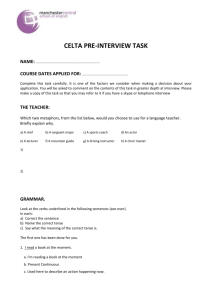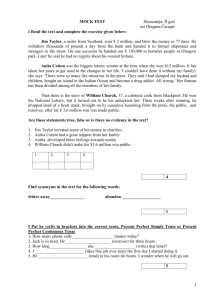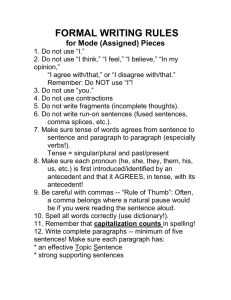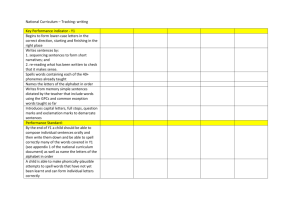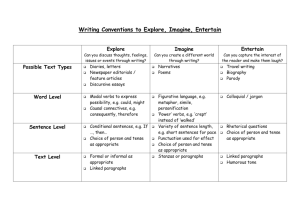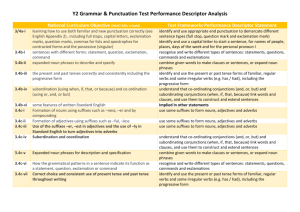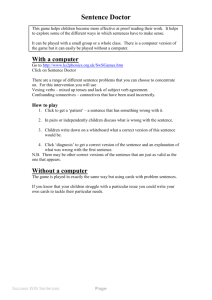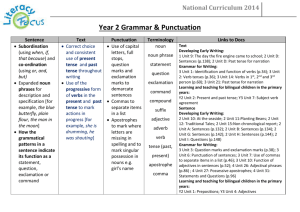I can…
advertisement
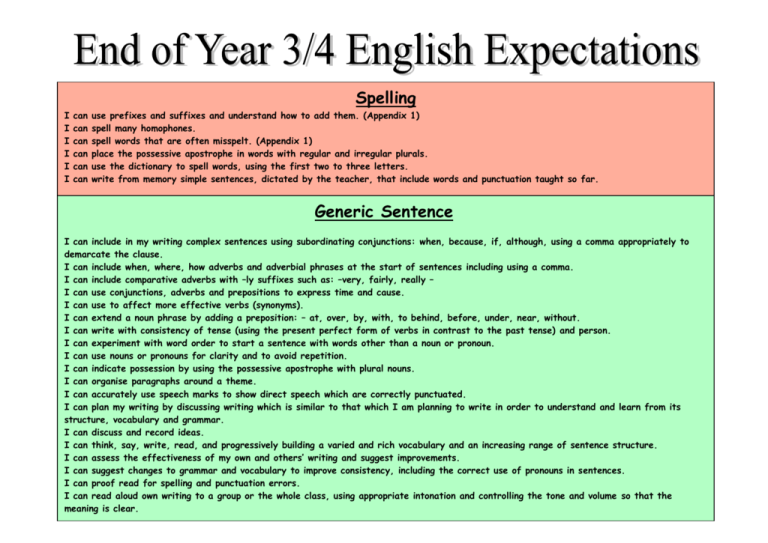
Spelling I I I I I I can can can can can can use prefixes and suffixes and understand how to add them. (Appendix 1) spell many homophones. spell words that are often misspelt. (Appendix 1) place the possessive apostrophe in words with regular and irregular plurals. use the dictionary to spell words, using the first two to three letters. write from memory simple sentences, dictated by the teacher, that include words and punctuation taught so far. Generic Sentence I can include in my writing complex sentences using subordinating conjunctions: when, because, if, although, using a comma appropriately to demarcate the clause. I can include when, where, how adverbs and adverbial phrases at the start of sentences including using a comma. I can include comparative adverbs with –ly suffixes such as: –very, fairly, really – I can use conjunctions, adverbs and prepositions to express time and cause. I can use to affect more effective verbs (synonyms). I can extend a noun phrase by adding a preposition: – at, over, by, with, to behind, before, under, near, without. I can write with consistency of tense (using the present perfect form of verbs in contrast to the past tense) and person. I can experiment with word order to start a sentence with words other than a noun or pronoun. I can use nouns or pronouns for clarity and to avoid repetition. I can indicate possession by using the possessive apostrophe with plural nouns. I can organise paragraphs around a theme. I can accurately use speech marks to show direct speech which are correctly punctuated. I can plan my writing by discussing writing which is similar to that which I am planning to write in order to understand and learn from its structure, vocabulary and grammar. I can discuss and record ideas. I can think, say, write, read, and progressively building a varied and rich vocabulary and an increasing range of sentence structure. I can assess the effectiveness of my own and others’ writing and suggest improvements. I can suggest changes to grammar and vocabulary to improve consistency, including the correct use of pronouns in sentences. I can proof read for spelling and punctuation errors. I can read aloud own writing to a group or the whole class, using appropriate intonation and controlling the tone and volume so that the meaning is clear. Narrative Recount (Myths and Legends, Familiar Settings) I can… Write a beginning, middle and end of a known story including setting, character and plot. I can… Change an aspect/ending of a known story. Use time connectives Experiment with a variety of sentence openers Use adventurous adjectives and like similes Write using the past tense Include speech Use a range of synonyms for ‘said’ Use adverbs at the start of sentences. Poetry Non-Chronological Report I can… Open sentences in variety of ways Write in the past tense. Structure a beginning, middle and end. Use time connectives Use adventurous vocabulary. Use comparative adverbs. Include a few personal reflective statements Make simple notes under provided sub-heading using given sources Convert notes into text Write an opening as an introduction Use the past tense include noun phrases Engage the reader with a lead in question Persuasion Instruction I can explore… I can… Creating images through poetry Different styles of Use of alliteration. poetry Write an opening statement Use the present tense Use logical connectives Use emotive language Use conditional statement ‘if’ Back up arguments with facts I can… Write a title to explain what the instructions are about Use imperative verbs, adverbs and technical vocabulary. Write a concluding statement Use time order words organise writing using headings and bullet points Write in clear and concise sentences Use commas in a list Explicitly taught spoken language lessons should occur every fortnight for 30 minutes, plus opportunities for daily speaking and listening through cross curricular links. Pupils should be taught to: Give well-structured descriptions, explanations and narratives for different purposes, including expressing feelings. Maintain attention and participate actively in collaborative conversations, staying on topic and initiating and responding to comments. Use spoken language to develop understanding through speculating, hypothesising, imagining and exploring ideas. Speak audibly and fluently with an increasing command of Standard English. Participate in discussions, presentations, performances, role play, improvisations and debates Gain, maintain and monitor the interest of the listeners. Consider and evaluate different viewpoints, attending to and building on the contributions of others. Select and use appropriate registers for effective communication. To be taught three times weekly; once as a direct teacher session (20/30 minutes) and twice consolidated during independent practise. Pupils will be taught to: Children should be taught tricky joins. Emphasis should be placed upon consistent sizing of capital letters and ascending letters, plus descenders should be the same length. By Year 3 Spring term, all children should be writing cursively at speed. The use of a black handwriting pen should be introduced during Year 3. By Year 4 children should use the cursive style across the curriculum. Reading Expectations: Word reading: I can… Apply my growing knowledge of root words, prefixes and suffixes (etymology and morphology) as listed in Appendix 1, both to read aloud and understand the meaning of new words I meet. Read further exception words, noting the unusual correspondence between spelling and sound, and where these occur within words. Reading comprehension: I can… Listen to and discuss a wide range of fiction, poetry, plays, non- fiction and reference books or text books. Read books that’s are structured in different ways and read for a range of purposes. Use dictionaries to check the meaning of words that I have read. Increased my familiarity with a wide range of books, including fairy stories, myths and legends and retell some of these orally. Identify themes and conventions in a wide range of books. Prepare poems and plays to read aloud and to perform, showing understanding through intonation, tone, volume and action. Discuss words and phrases that capture the reader’s interest and imagination. Recognise different forms of poetry. Check that the text makes sense, discuss my understanding and explain the meaning of words in context. Ask questions to improve my understanding of the text. Draw inferences such as inferring characters’ feelings, thoughts and motives from their actions, and justifying inferences with evidence. Predict what might happen from details that are stated and implied. Identify main ideas from more than one paragraph and summarising them. Identify how language, structure and presentation contribute to meaning Retrieve and record information from non-fiction books. Participate in discussions about books.
